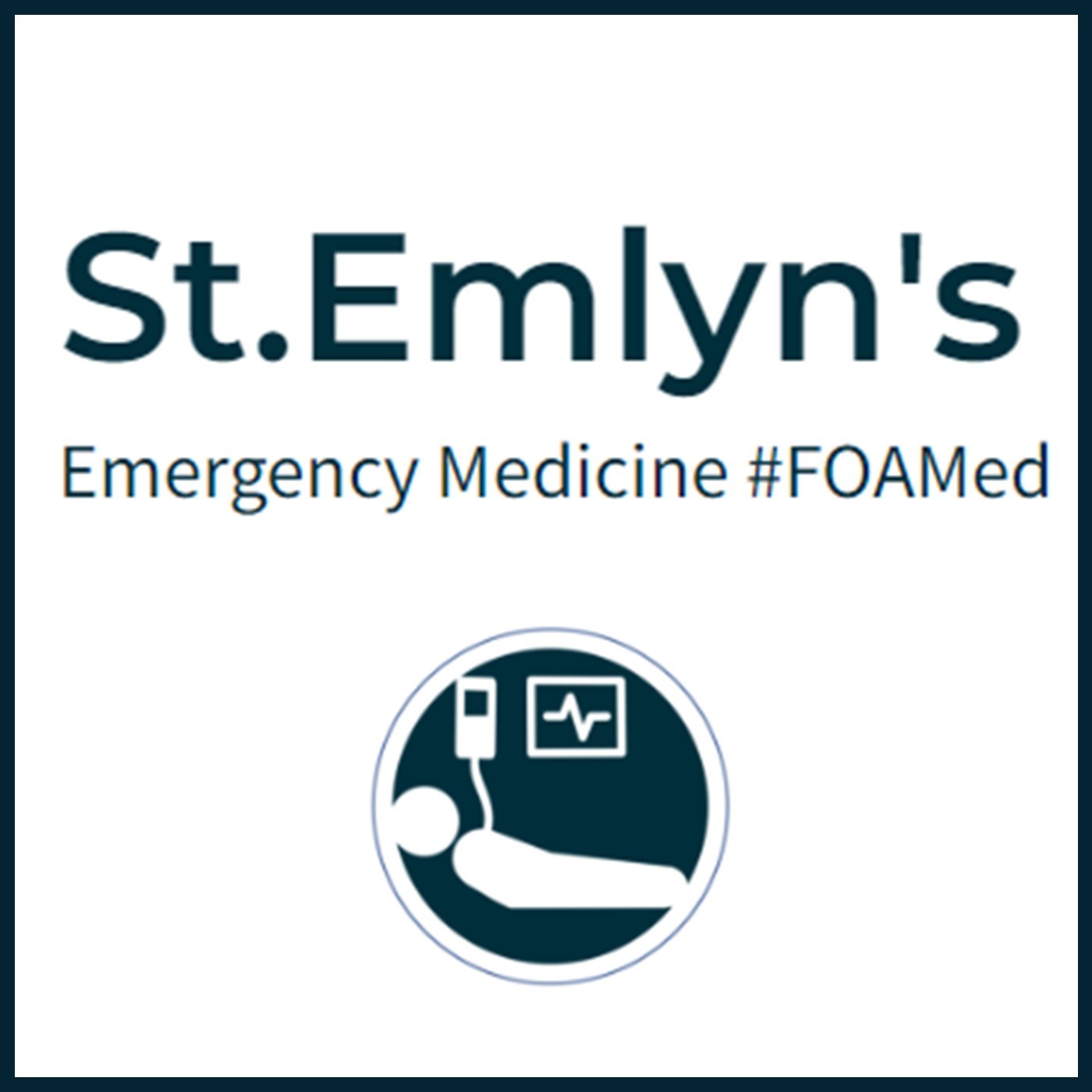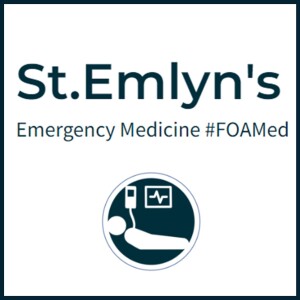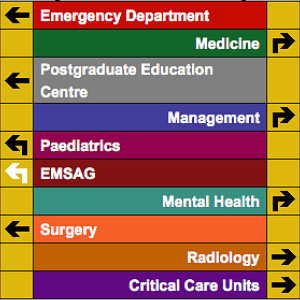
1.3M
Downloads
283
Episodes
A UK based Emergency Medicine podcast for anyone who works in emergency care. The St Emlyn ’s team are all passionate educators and clinicians who strive to bring you the best evidence based education. Our four pillars of learning are evidence-based medicine, clinical excellence, personal development and the philosophical overview of emergency care. We have a strong academic faculty and reputation for high quality education presented through multimedia platforms and articles. St Emlyn’s is a name given to a fictionalised emergency care system. This online clinical space is designed to allow clinical care to be discussed without compromising the safety or confidentiality of patients or clinicians.
Episodes

Wednesday Aug 21, 2024
Ep 242 - Prehospital Neuroprotection with Ed Langford at PREMIER 2024
Wednesday Aug 21, 2024
Wednesday Aug 21, 2024
In this episode, we delve into the critical role of neuroprotection in pre-hospital care, particularly in pediatric head injuries. Through a real-life case study of a 13-year-old boy who suffered a traumatic brain injury after being hit by a car, we explore the steps taken by paramedics and critical care teams to stabilize him and prevent further neurological damage. From airway management to advanced interventions, this episode highlights the challenges of pre-hospital neuroprotection and the incredible teamwork that led to the patient’s remarkable recovery.
There is more detail on the full blogpost here.
This podcast was recorded live at the Hope Church in Winchester as part of the PREMIER conference. We are grateful to the organizing team for hosting us and allowing us to use the audio. The PIER and PREMIER websites are full of amazing resources for anyone working in Paediatric Emergency Medicine, and we highly recommend them.
The Speaker
Ed is a Speciality Trainee in Emergency Medicine in Wessex and a trainee Critical Care Practitioner with Dorset and Somerset Air Ambulance. Ed is also the co-founder and Managing Director of Enhanced Care Services, a Southampton-based company delivering enhanced and critical care to the event medical sector, providing frontline ambulance services across Hampshire and clinical education at all levels, employing over 200 clinicians. Ed holds the Diploma in Immediate Medical Care (RCSEd) and, having promised to not take on any more work, is currently undertaking a Masters in Resuscitation, Pre-hospital and Emergency Medicine at QMUL.
Enhanced Care Services
Enhanced Care Services' mission is to provide and influence excellent patient care, irrespective of injury, illness or location, through the delivery of high-quality clinical operations and education. Founded in 2015, ECS now provide frontline ambulance operations across the South, delivers extensive medical cover to some of the most prestigious events across the UK and provides education from its bespoke education centre in Southampton and beyond.

Wednesday Jul 31, 2024
Ep 239 - Button Battery Ingestion with Francesca Steadman at PREMIER 2024
Wednesday Jul 31, 2024
Wednesday Jul 31, 2024
In this podcast from the PREMIER conference 2024, Francesca Stedman, a consultant paediatric surgeon from Southampton Children's Hospital discusses the care of the child who has ingested a button battery.
Button batteries are ubiquitous and come in various types and sizes. There are about 85 different kinds available or in use in the UK alone, found in everything from toys to hearing aids. The most notorious is the CR2032, which is about 20 millimeters in diameter and 3.2 millimeters thick. It contains lithium manganese oxide, and while its small size makes it convenient for electronics, it poses a significant risk if ingested.
The danger with button batteries lies in their potential to cause severe injuries when lodged in the esophagus. They can cause necrosis, which is essentially tissue death, due to a strong alkaline substance produced by the battery. This substance acts like a potent oven cleaner, rapidly causing damage. The esophagus has three natural narrowing points where these batteries often get stuck, increasing the likelihood of injury. The situation becomes critical very quickly, often within two hours of ingestion.
One of the most concerning aspects of these incidents is that button battery ingestions are rarely witnessed. Children might present with vague symptoms like drooling, difficulty swallowing, or even just being generally unwell. These can easily be mistaken for other common illnesses, leading to delays in diagnosis. In one particularly harrowing case, a child presented multiple times with symptoms of a respiratory infection, only for an x-ray to reveal a button battery lodged in the esophagus. By then, the damage was extensive.
When ingestion is suspected, immediate action is crucial. Getting a chest x-ray is the first step, and if necessary, a lateral x-ray can confirm the presence of a button battery by revealing a characteristic double rim or halo sign. Pre-hospital measures can include giving honey or jam, depending on the child’s age, to help mitigate the damage. However, these should never delay getting the child to the hospital.
Once at the hospital, the primary goal is to remove the battery as quickly as possible to prevent further injury. Depending on the location of the battery and available specialists, either ENT surgeons or paediatric surgeons may perform the removal. Post-removal care involves monitoring for complications like perforations or fistulas, which can develop days or even weeks later. In severe cases, these injuries can lead to life-threatening conditions, such as aorto-esophageal fistulas, which require immediate surgical intervention.
In summary, button battery ingestion is a serious and often underappreciated risk. Even in homes where precautions are taken, accidents can happen. The key is quick recognition and action. As parents and caregivers, we need to be vigilant about keeping these small, dangerous objects out of children's reach. And if an accident does occur, immediate medical attention is essential to minimize the risk of serious injury.
More details are available on the blogpost here.

Wednesday Jul 17, 2024
Ep 237 - Hybrid Closed Loop Insulin Pumps with Nicola Trevelyan at PREMIER 2024
Wednesday Jul 17, 2024
Wednesday Jul 17, 2024
In today's episode, taken from live recordings at PREMIER 2024, we dive into an increasingly common treatment for type 1 diabetes: hybrid closed loop insulin pumps. We'll begin with a brief overview of traditional insulin pumps and explain how hybrid closed loops are different. The core of our discussion will be centered around three case studies, illustrating potential scenarios you might encounter in a pediatric emergency department and how to manage them effectively.
With NICE's recent technology appraisal advocating for universal access to hybrid closed loop systems for all type 1 diabetes patients, it's crucial to understand these devices. Over the next few years, you'll likely encounter these systems frequently. We'll cover the essentials of how these pumps work, their benefits, and potential issues that might arise, such as connectivity problems, cannula issues, and handling intercurrent illnesses.
Join us as we explore the revolutionary impact of hybrid closed-loop systems, which offer better glucose control and significantly improve the quality of life for those with type 1 diabetes.
Dr Nicola Trevelyan has been the Clinical Lead for the Paediatric Diabetes Service in Southampton for the last 20 years. During this time, she has seen huge changes in the management of CYP with diabetes. She has been involved in several large multicentre trials for paediatric diabetes, helping to better our understanding of how best to use new technologies in diabetes management in children and move forward access to new treatment technologies. She was one of the founding committee members for the Assoc of Children's Diabetes Clinicians (ACDC) in 2006 and has been on working parties for BSPED helping evidence base and re-write the national DKA guidelines in 2020 and for the National Paediatric Diabetes Audit. For the last 4 years, she has been on the Clinical Advisory Group for the RCPCH Quality Improvement Programme for Paediatric Diabetes.

Saturday Jun 17, 2023
Ep 219 - Blast Injuries with Chris Hillman at the PREMIER Conference
Saturday Jun 17, 2023
Saturday Jun 17, 2023
Chris brought us his reflections amnd knowledge from some of his extensive experience as a military EM consultant in two wars. Blast injury could be blunt, penetrating, may involve major haemorrhage: you have to expect any injury possible. It’s worldwide and it’s getting more common.
Blast injury affects every body cavity, but it is the CABC approach that matters, Doing the basics well is still the key. Bleeding points may not be obvious so apply tourniquets wherever stops the bleeding.
Often patients will not arrive in ones or twos but as a whole group affected by an incident, so it is vital we are prepared. The Paediatric Blast Injury Field Manual is a free resource available to download here and is highly recommended.
Chris Hillman is a Consultant in Emergency Medicine and Paediatric Emergency Medicine, working in Southampton. Serving in the Royal Navy since university, he has deployed on Ships, Submarines and with Commando units globally, and with the Army to Afghanistan and Iraq. He is the outgoing Consultant Advisor in Emergency Medicine and Clinical Director Commando Forward Surgical Group.

Tuesday Jun 13, 2023
Ep 217 - Weaning the wheezy child with David James at the PREMIER Conference
Tuesday Jun 13, 2023
Tuesday Jun 13, 2023
This is the first in a series of podcasts, recorded live at the Premier Conference in Winchester.
In this episode, David James challenges our current practice when we give a 'weaning plan' for children discharged with wheeze.
There is a plan here that you can review and give to patients and their carers.
More information at these excellent websites
David James has been a PEM Consultant at University Hospital Southampton since 2018. His main interests are in training and education, adolescent emergency medicine and Quality Improvement. He is the Divisional Director of Medical Education and a Training advisor on the PEMISAC. He is the acute care lead for Wessex Healthier Together and has led several projects including those around acute wheeze at UHS and regionally. Outside of work he enjoys swimming, cycling and running and is extremely average at triathlons.

Sunday Jul 14, 2019
Ep 141 - June 2019 Round Up
Sunday Jul 14, 2019
Sunday Jul 14, 2019
The Paradox of a Good Day in Emergency Medicine: Key Insights
Emergency medicine is a field full of paradoxes, where the definition of a "good day" can differ starkly between healthcare professionals and their patients. This contradiction was a central theme in the discussions from June, which included reflections on the Don’t Forget the Bubbles (DFTB) conference, as well as key topics like the emotional toll of emergency medicine, the evolving nature of adolescent healthcare, and the importance of continuous learning.
Don’t Forget the Bubbles Conference: A Valuable Resource for Pediatric Emergency Medicine
The DFTB conference, held in London this year, has quickly become an essential event for those involved in pediatric emergency medicine. With a focus on both pediatric and adolescent healthcare, the conference offers invaluable insights and practical advice that can benefit even those who primarily work in adult emergency medicine.
One of the standout topics from the conference was the Paradox of a Good Day in Emergency Medicine. This paradox arises from the nature of emergency medicine, where a "good day" for a clinician—filled with successful procedures and exciting cases—often coincides with what is likely the worst day of a patient’s life. This duality highlights the emotional and ethical complexities that emergency physicians must navigate. As practitioners advance in their careers, they often shift from focusing on the technical aspects of their work to becoming more aware of the profound impact these situations have on patients and their families.
The Emotional and Psychological Impact of Emergency Medicine
The emotional burden of emergency medicine was another significant theme at the DFTB conference, especially in sessions led by Kim Holt and Neil Spenceley. Holt, who has been involved in whistleblowing in the high-profile Baby P case, shared her experiences of dealing with criticism and professional challenges. Her story serves as a reminder of the resilience required to navigate the ethical and emotional complexities of healthcare.
Spenceley’s session on doctors in distress emphasized the importance of creating supportive systems within healthcare departments. He argued that instead of focusing on making individuals more resilient, we should design systems that inherently support healthcare professionals. This shift in perspective is crucial in addressing the high levels of burnout and stress among emergency medicine practitioners.
Laura Howard’s research on the psychological well-being of emergency physicians further explored this issue. Her qualitative study, which involved interviews with senior emergency physicians, revealed that the emotional impact of the job affects everyone, regardless of their experience level. Events like traumatic deaths, particularly those involving children or body disruptions, were identified as particularly distressing and had lasting effects on the practitioners involved. Howard’s work underscores the need for robust support systems to help clinicians manage the cumulative toll of their work.
Bridging the Gap in Adolescent Medicine
The DFTB conference also shed light on the often-overlooked area of adolescent healthcare. As healthcare providers, we tend to categorize patients as either adults or children, but adolescents require a tailored approach that addresses their unique needs. Russell Viner, a leader in pediatric healthcare, discussed how the concept of adolescence has evolved over time. In previous generations, adolescence was a brief period between puberty and adulthood, often marked by early milestones like starting a family. Today, however, adolescence is prolonged, with young people delaying traditional markers of adulthood due to social, educational, and economic factors.
This shift has significant implications for how we approach healthcare for adolescents. In our practice, we must ensure that we are not only addressing the physical health of teenagers but also their mental and emotional well-being. This includes creating healthcare environments that are welcoming and appropriate for adolescents and offering resources that cater to their specific health concerns.
Continuous Learning: Beyond ATLS and Traumatic Cardiac Arrest
The importance of continuous learning and staying current with the latest research and best practices was another key message from June. Alan Grayson’s talk on going beyond ATLS (Advanced Trauma Life Support) was particularly impactful. While ATLS has been a cornerstone of trauma care globally, Grayson challenged us to think critically about its limitations, especially in high-income countries where multi-disciplinary teams are the norm.
Grayson emphasized the need to focus on the basics—such as administering tranexamic acid, providing adequate analgesia, and ensuring timely administration of antibiotics—before diving into more advanced interventions like REBOA (Resuscitative Endovascular Balloon Occlusion of the Aorta). This back-to-basics approach serves as a crucial reminder that even in a high-tech medical environment, the fundamentals of care are what ultimately save lives.
Jason Smith’s session on traumatic cardiac arrest offered new insights into how we approach this challenging situation. Traditional management has focused on chest compressions, adrenaline, and fluid resuscitation, but emerging evidence suggests that in cases of traumatic cardiac arrest, these interventions may not be as beneficial as once thought. Instead, giving blood and stopping the bleeding were identified as more critical interventions. However, Smith cautioned that this approach should be reserved for hypovolemic cardiac arrest, highlighting the importance of understanding the underlying cause of the arrest before determining the treatment course.
The Reality of Intraosseous (IO) Blood Sampling
A more technical but equally important topic discussed in June was the use of intraosseous (IO) blood sampling. For years, many clinicians have been taught that IO access can provide reliable blood samples for analysis. However, recent evidence suggests otherwise. A systematic review revealed that while it might be possible to obtain certain values like hemoglobin and sodium, the reliability of these results is questionable. Moreover, using IO samples for blood gas analysis or putting marrow through automatic analyzers can lead to equipment malfunction, a concern that has understandably caused anxiety among laboratory staff.
Given this evidence, it’s clear that we need to rethink our approach to IO blood sampling. While it might still have a place in certain situations, particularly for microbiological cultures, relying on IO samples for comprehensive blood analysis is not advisable. This is another example of how continuous learning and critical evaluation of existing practices are essential for improving patient care and ensuring the best possible outcomes.
Conclusion: Moving Forward with Insights from June
As we reflect on the lessons from June, it’s evident that emergency medicine is a constantly evolving field that demands both continuous learning and emotional resilience. Whether through attending conferences like Don’t Forget the Bubbles, staying updated on the latest research, or addressing the psychological impact of our work, it’s clear that adaptation and mutual support are key to thriving in this challenging yet rewarding profession.
At St Emlyn's, we are committed to fostering a culture of lifelong learning, open discussion, and mutual support. As we move into the second half of the year, let’s carry forward the insights we’ve gained, keep pushing the boundaries of our knowledge, and continue to support each other in the demanding yet rewarding field of emergency medicine. Take care, and keep up the incredible work you do.

Friday Jun 21, 2019
Ep 139 - May 2019 Round Up
Friday Jun 21, 2019
Friday Jun 21, 2019
St. Emlyn's Podcast: Key Insights from May in Emergency Medicine
As we transition into the warmer months, it's an opportune time to reflect on recent discussions and developments within the field of emergency medicine, particularly those highlighted in the latest episode of the St. Emlyn's podcast. This episode covered a wide range of topics, from workplace safety to advancements in pediatric care and innovative approaches in patient management. Below is a comprehensive summary of the key points discussed.
Workplace Safety: A Pressing Concern
The podcast began with a reflection on a recent violent incident at Newham Emergency Department (ED), which served as a stark reminder of the dangers healthcare professionals face daily. Emergency departments, by their very nature, are open and accessible, making them vulnerable to violent incidents. This recent attack has prompted a nationwide reassessment of safety measures, with many EDs enhancing their protocols to protect staff.
The conversation emphasized that violence in the workplace should never be normalized. It’s crucial that healthcare professionals feel safe and supported in their working environment. Leadership within departments plays a critical role in this, not only by implementing robust safety protocols but also by fostering a culture of solidarity and mutual support among staff. The incident at Newham underscores the need for constant vigilance and proactive measures to ensure the safety of everyone working in emergency medicine.
Leadership in Education: Simon Carley’s New Role
In more positive news, Simon Carley’s recent appointment as the CPD (Continuing Professional Development) lead for the college was discussed. This role is a significant milestone, not just for Simon but also for the integration of modern educational approaches within formal medical education. Simon’s involvement with St. Emlyn's has long been focused on innovative, social media-driven education, and this new role offers an opportunity to bring these methods into a broader educational framework.
The appointment highlights the value of combining traditional education with the dynamic, accessible formats offered by the #FOAMed (Free Open Access Meducation) community. It’s a recognition that medical education can benefit from new perspectives and that the integration of these ideas can enhance the learning experiences for healthcare professionals.
Pediatric Status Epilepticus: Evaluating Second-Line Agents
The discussion moved to a detailed analysis of pediatric status epilepticus, focusing on the findings from two key trials: the Eclipse trial and the ConSEPT trial. These studies compared the efficacy of levetiracetam (Keppra) and phenytoin as second-line agents for stopping seizures in children.
The trials found no significant difference between the two drugs in terms of their effectiveness, which has led to debate within the medical community about whether to switch from phenytoin to levetiracetam. While levetiracetam is perceived as easier to administer and safer, the lack of a clear superiority has left the decision somewhat open. However, the ease of use and safety profile of levetiracetam make it an appealing option, and some institutions are considering making the switch.
For clinicians, the takeaway is that while both drugs are viable options, the choice may ultimately come down to individual preferences and institutional protocols. The trials underscore the importance of continuous evaluation of treatment options, particularly in complex cases like pediatric seizures.
Understanding Clinical Trials: The Importance of Statistical Literacy
Simon Carley also highlighted the importance of understanding the statistical nuances in clinical trials, particularly the difference between demonstrating a difference between treatments and establishing their equivalence. This distinction is crucial for accurately interpreting research findings and making informed clinical decisions.
The discussion emphasized that clinicians must be cautious in how they interpret trial results, particularly when it comes to determining whether treatments are genuinely equivalent or if the lack of a significant difference merely reflects the study’s design. This level of critical appraisal is essential for ensuring that new research is applied correctly in clinical practice.
Prolonged Field Care in the ED: Learning from Military Medicine
Another topic discussed was prolonged field care, a concept borrowed from military medicine that is becoming increasingly relevant in emergency departments due to overcrowding and delays. Rich Carden introduced the HITMAN mnemonic—Hygiene and Hydration, Infection, Tubes, Medication, Analgesia, and Nutrition—as a framework for managing patients who are stuck in the ED for extended periods.
The HITMAN approach ensures that patients' fundamental needs are met even when resources are stretched. This method helps prevent complications and improves patient outcomes, even in less-than-ideal conditions. The approach is particularly relevant in today’s healthcare environment, where EDs are often overwhelmed and patients may wait longer than usual for admission or transfer.
Atrial Fibrillation: Reassessing Cardioversion Strategies
Atrial fibrillation (AF) management was another key topic. A recent study in the New England Journal of Medicine compared immediate cardioversion with a wait-and-see approach in patients with new-onset AF. The study found that a wait-and-see approach was non-inferior to immediate cardioversion, with 69% of patients in the wait-and-see group spontaneously cardioverting within 48 hours.
This finding challenges the traditional approach of immediate cardioversion and suggests that in many cases, a more conservative approach may be just as effective. However, the decision should be made through shared decision-making with the patient, taking into account their preferences and the specific circumstances of their condition. This patient-centered approach ensures that treatment decisions are made collaboratively and with the patient’s best interests in mind.
Traumatic Cardiac Arrest: Reevaluating Chest Compressions
The podcast also touched on the evolving management of traumatic cardiac arrest, particularly the role of chest compressions. Recent studies, including one involving porcine models, suggest that in cases of hypovolemic traumatic cardiac arrest, chest compressions may not be beneficial and could even be harmful. Instead, the focus should be on addressing the underlying cause, such as restoring circulating volume.
This shift in practice highlights the importance of understanding the specific etiology of cardiac arrest and tailoring resuscitation efforts accordingly. Communicating these changes to the entire resuscitation team is crucial, as there may be resistance to deviating from traditional protocols. Ensuring that everyone is on the same page and understands the rationale behind the approach is key to successful implementation.
Virtual Reality in Pain Management: An Emerging Tool
Virtual reality (VR) is emerging as a promising tool in pain management, particularly in pediatric patients undergoing painful procedures. A recent study discussed in the podcast found that children who used VR experienced less distress during procedures compared to those who received standard care.
VR offers an innovative, accessible method for managing pain and anxiety, and its use is likely to expand in the coming years. The ability to create immersive environments that distract patients during procedures has the potential to improve patient experiences and outcomes, not just in children but potentially in adults as well.
The Power of Peer Review: Enhancing Clinical Practice
Finally, Simon Carley discussed the importance of peer review in clinical practice. Peer review is a valuable tool for continuous improvement, allowing clinicians to receive feedback from colleagues on their performance. While it can be challenging to create a culture where feedback is welcomed and constructive, the benefits are significant.
Peer review helps clinicians avoid complacency, stay up-to-date with best practices, and continually refine their skills. It’s a simple, cost-effective way to ensure that healthcare professionals are delivering the highest standard of care. Creating a supportive environment where feedback is seen as an opportunity for growth rather than criticism is essential for the success of peer review initiatives.
Conclusion
The discussions in this month’s St. Emlyn's podcast highlight the complexities and challenges of working in emergency medicine, from ensuring workplace safety to staying current with evolving practices. By engaging with new research, embracing innovative tools like virtual reality, and fostering a culture of continuous improvement through peer review, we can continue to advance the field and improve patient care. As always, the St. Emlyn's blog and podcast remain valuable resources for staying informed and connected with the latest developments in emergency medicine.

Thursday Aug 17, 2017
Ep 97 - Foreskins: A PED primer with Ross Fisher
Thursday Aug 17, 2017
Thursday Aug 17, 2017
Comprehensive Guide to Managing Foreskin Issues in Pediatric Emergency Care
In pediatric emergency departments, foreskin-related issues frequently present significant challenges. This guide provides a thorough overview of common conditions such as balanitis, paraphimosis, and Balanitis Xerotica Obliterans (BXO), offering evidence-based strategies for their effective management.
1. Balanitis: Understanding and Managing Inflammation
Definition and Presentation: Balanitis refers to inflammation of the glans penis, often accompanied by inflammation of the foreskin (balanoposthitis). Symptoms include redness, swelling, and discomfort. It is a common presentation in emergency departments (EDs) and can cause significant concern among parents and caregivers.
Management Approach:
-
Avoid Over-Treatment: Many cases of balanitis resolve spontaneously without the need for aggressive treatment. Over-treatment often includes unnecessary antibiotics and topical creams. Most cases are due to simple inflammation rather than bacterial infection.
-
Antibiotics: Routine use of antibiotics is generally unnecessary unless a clear bacterial infection is identified. Antibiotics do not significantly impact the natural course of uncomplicated balanitis and may contribute to resistance.
-
Topical Treatments: Using topical treatments like chloramphenicol eye ointment is discouraged. These treatments can cause additional pain and discomfort, exacerbating symptoms rather than alleviating them.
-
Reassurance: Educating parents about the self-limiting nature of balanitis and advising them to avoid unnecessary treatments is crucial. Most cases improve with minimal intervention, and reassurance can significantly reduce anxiety.
2. Paraphimosis: Effective Management Strategies
Definition and Causes: Paraphimosis occurs when the foreskin is retracted behind the glans penis and cannot be returned to its normal position. This condition can lead to swelling, pain, and potential complications if not managed promptly.
Management Techniques:
-
Gentle Reduction: The primary approach involves applying firm, consistent pressure to the glans penis to reduce swelling and facilitate the repositioning of the foreskin. This technique is often successful and avoids the need for surgical intervention.
-
Lubrication: Using lubrication can assist in the reduction process. Avoid home remedies like ice or sugar, which lack scientific support and may not be effective.
-
Reassurance: Communicate to parents that paraphimosis is usually manageable with conservative techniques and that surgical intervention is rarely needed. Educating families about the condition and its management can help alleviate concerns.
3. Balanitis Xerotica Obliterans (BXO): Diagnosis and Management
Definition and Characteristics: BXO is a chronic condition characterized by a white, shiny scar at the tip of the foreskin and glans penis. It primarily affects boys over the age of five and can lead to ballooning of the foreskin due to scarring.
Diagnosis:
-
Clinical Examination: Diagnosis involves looking for a white, shiny scar at the end of the foreskin, indicative of BXO. This scarring distinguishes BXO from other forms of balanitis.
-
Age Consideration: BXO is uncommon in children under five. Accurate diagnosis based on age and symptom presentation is essential for appropriate management.
Management:
-
Specialist Referral: Severe cases of BXO often require referral to a specialist. Treatment may involve circumcision or other interventions depending on the severity of the condition.
-
Conservative Measures: For less severe cases, topical steroids may be used, but definitive treatment often involves surgical options to address scarring and prevent further complications.
4. Post-Circumcision Complications: Common Issues and Management
Common Issues: Post-circumcision complications include minor bleeding and concerns about the appearance of the circumcised penis. These issues can cause anxiety and prompt visits to the ED.
Management Strategies:
-
Bleeding: Minor bleeding is a common post-circumcision issue. Apply direct pressure to control bleeding. If bleeding persists, topical treatments such as tranexamic acid or adrenaline can be used, but most cases resolve with basic first aid.
-
Appearance Concerns: The appearance of the circumcised penis may look bruised or inflamed initially but typically improves as healing progresses. Reassure parents that these changes are normal and part of the healing process.
Community vs. Hospital Circumcision: Circumcisions performed in the community often have fewer reported complications compared to those done in hospitals. This difference is due to the larger number of community circumcisions and the varying rates of complication reporting.
5. Practical Tips for Pediatric Emergency Care
Key Considerations:
-
Age and Diagnosis: Always consider the child’s age when diagnosing and managing foreskin issues. Conditions like BXO are rare in younger children, while balanitis and paraphimosis are more common.
-
Conservative Management: A conservative approach is usually effective for most foreskin issues. Avoid unnecessary treatments and focus on reassurance and education.
-
Parent Education: Educate parents about the nature of the condition, expected outcomes, and appropriate management strategies. This helps reduce anxiety and prevent over-treatment.
-
Specialist Referral: For conditions requiring specialized care, such as BXO or severe post-circumcision complications, timely referral to a specialist is crucial for optimal management.
Conclusion: Embracing a Conservative Approach
Summary: Managing foreskin issues in pediatric emergency care involves understanding common conditions such as balanitis, paraphimosis, and BXO. Adopting a conservative, evidence-based approach helps avoid over-treatment and ensures effective management. Reassure families, provide appropriate care, and refer to specialists when needed. By following these practices, clinicians can enhance patient care and contribute to better outcomes for young patients with foreskin-related issues.
